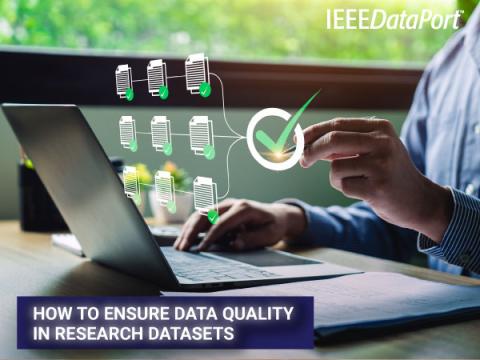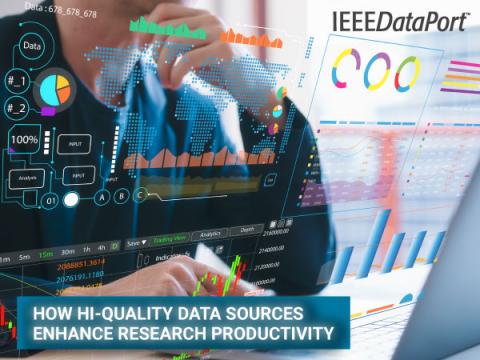Harnessing Research Data and AI: How to Leverage Data Analytic Services to Match Your Needs
In today's data-driven world, the sheer volume of information generated daily is staggering overwhelming. The massive influx of data today presents many complex challenges for research departments across all sectors. Statistics clearly indicate there’s a critical need for robust solutions to manage and leverage all the data being produced in an effective way to ensure it supports value creation and fulfills diverse organizational needs.
IDC estimates that less than 5% of all data is currently tagged and research by Statista reports that only two percent of data produced is saved and retained.
Consider these staggering statistics:
- By 2025, the world is expected to produce over 180 zettabytes of data.
- Around 2.5 quintillion bytes of data are generated each day.
- The big data analytics market is predicted to reach $349.56 billion in 2024.
This explosive growth in data generation is driven by several factors:
- Proliferation of connected devices and Internet of Things (IoT) technologies
- Digital transformation initiatives across industries
- Increased online activities and user-generated content
The sheer volume and complexity of this data present significant challenges for traditional analytical methods. As a result, there is a growing need for advanced analytics tools and techniques that can efficiently process and derive insights from these massive datasets while supporting data access needs.
The Critical Role of Data Analytics in Research
Data analytics is more than just crunching numbers. In the world of research, data analytics plays a crucial role in helping scientists and scholars get the most from academic research databases.
At its core, data analytics involves key data management activities including collecting, organizing, and analyzing data to draw conclusions and make predictions. In order to yield meaningful results, data must be put through analytical testing for the following purposes:
- Data interpretation
- Pattern recognition
- Validation
- Decision making
- Hypothesis testing
The benefits of big data analytics in research are numerous:
- Faster discovery: Advanced analytics tools can process large datasets much more quickly than traditional methods, accelerating the pace of scientific discovery.
- A more thorough analysis: By studying larger and more varied datasets, researchers can understand complex phenomena better.
- Better accuracy: Machine learning algorithms can find patterns and connections that human analysts might overlook. This leads to more accurate conclusions.
- Enhanced collaboration: Data analytics platforms make it easier for researchers to enjoy easy data access and share and collaborate on datasets, fostering interdisciplinary research and innovation.
- Predictive capabilities: Predictive data analytics services can predict future trends and outcomes using past data. This helps researchers make better decisions.
As the volume and complexity of research data continue to grow, the importance of sophisticated data analytics services in academia will only increase.
Why It’s Time to Rethink Data Analytics Tools & Procedures
For years, researchers have relied on traditional statistical methods and human analytical skills to make sense of their data. While these approaches have yielded valuable insights, they're increasingly inadequate for handling the scale and complexity of modern datasets.
Machine learning data and artificial intelligence (AI) are not just futuristic ideas anymore. They are part of our daily lives. In the world of research, AI-powered data analytics services are transforming how we approach data analysis. These services employ AI-powered tools to quickly and accurately process large amounts of information, helping researchers identify insights that might stay hidden otherwise.
Physicist Mario Krenn sees artificial intelligence as a muse — a source of inspiration and ideas for scientists. Dr. Krenn's collaborations at the Max Planck Institute for the Science of Light led to the development of AI algorithms that help scientists observe a specific type of quantum entanglement.
“I let the algorithm run, and within a few hours it found exactly the solution that we as human scientists couldn’t find for many weeks,” he said. Using the blueprint created by the computer, his colleagues were able to build the setup in the laboratory and use it to observe the phenomenon for the first time.
Machine learning and other advanced tools can:
- Provide data access to a large group of researchers who need accurate analytics
- Process vast amounts of data at incredible speeds
- Identify complex patterns and relationships that humans might overlook
- Generate predictive models to forecast future trends
- Analyze unstructured data like text, images, and videos
- Automate routine data management tasks, freeing up researchers for higher-level analysis
IEEE DataPort subscribers will be pleased to know they are provided an AWS access key that accesses datasets on AWS. Subscribers can subsequently use their own AWS account to perform any analytics.
How AI Can Help Fill the Gaps in Research
AI isn't just making data analysis faster and more efficient – it's also helping to fill critical gaps in research. Here are some ways predictive data analytics services and machine learning data are revolutionizing the research process:
New insights: AI can identify connections between seemingly unrelated datasets, fostering collaboration across different fields of study. For example, a link may be discovered between climate data and public health statistics, leading to new insights in environmental health research.
Improved reproducibility: By automating data analysis processes, AI can help ensure consistency and reproducibility in research findings. This is particularly important in fields like psychology and medicine, where reproducibility has been a significant challenge.
Accelerated literature reviews: Natural language processing algorithms can quickly analyze thousands of research papers, helping researchers stay up-to-date with the latest developments in their field. This can save months of manual review work and ensure that researchers don't miss crucial information.
Generated datasets for AI: In fields where data is scarce or sensitive, AI can create realistic synthetic datasets for training and testing algorithms. This is particularly useful in medical research, where patient privacy concerns often limit data availability.
Predicted research outcomes: Predictive analytics services can help researchers anticipate the potential impact of their work and identify promising areas for future study. This type of data access can guide research priorities and resource allocation more effectively.
The Power of Machine Learning in Data Analytics
Machine learning, a subset of AI, is at the forefront of the data analytics revolution. Machine learning uses algorithms to make predictions or decisions based on data. Here are some ways machine learning is enhancing data analytics services:
- Automated feature selection: The most relevant features in a dataset can be identified, saving time and uncovering important variables that might have been overlooked.
- Anomaly detection: Unusual patterns or outliers in data can be identified, assisting in fraud detection, quality control, and identifying anomalies.
- Clustering and classification groups with similar data points or categorizes new data.
- Time series analysis identifies trends, seasonality, and makes forecasts.
- Natural Language Processing (NLP): This branch of machine learning enables computers to understand, interpret, and generate human language.
- The application of machine learning in data analytics is not just making research more efficient – it opens up new possibilities for discovery and innovation.
AI-Powered Tools for Academic Research Databases
AI-powered tools are making it easier than ever for researchers to find relevant studies, analyze large bodies of literature, and even generate new hypotheses.
Here are some ways AI is enhancing academic research databases:
Intelligent search algorithms: understand the context and intent behind a researcher's query, providing more relevant results than traditional keyword searches. For example, a search for "climate change impacts" might also return results about "global warming effects" or "environmental shifts".
Automated literature reviews analyze thousands of papers on a given topic, summarizing key findings, identifying trends, and highlighting gaps in the research.
Citation analysis: AI algorithms analyze citation networks to identify influential papers, emerging research trends, and potential collaborators in a field of study.
Personalized recommendations: AI tools suggest relevant papers based on a researcher's reading history and areas of interest.
Data visualization tools: AI-powered visualization tools can create interactive graphs and charts that reveal patterns and relationships in the data.
Plagiarism detection: Advanced AI algorithms can compare submitted papers against vast databases of published work, helping to maintain academic integrity.
Language translation: Translation tools can break down language barriers in research, allowing scholars to access and understand papers published in other languages.
AI-enhanced tools are not only making research more efficient but also more comprehensive and inclusive, allowing researchers to draw insights from a broader range of sources than ever before.
Tips for Using IEEE DataPort to Get More from Your Data Analysis
IEEE DataPort offers a comprehensive platform for storing, sharing, and analyzing research data, leveraging the power of AI and advanced analytics tools. Our platform provides researchers with the resources they need to securely harness the full potential of their data and drive innovation in their fields.Key features of IEEE DataPort for data analytics:
Scalable Storage: Store datasets up to 2TB (or 10TB for institutional subscribers), accommodating large-scale research projects.
Data Access Management Tools: Utilize our Data Management Plan creator tool to streamline your data management processes.
Integration with Analytics Platforms: IEEE DataPort is fully integrated with Amazon Web Services (AWS), facilitating advanced data analytics and machine learning applications.
Collaboration Features: Share datasets with colleagues, participate in data competitions, and foster interdisciplinary research.
Visibility and Impact Tracking: Monitor dataset views and citations to gauge the impact of your research data.
Reproducibility Support: Upload scripts and documentation alongside datasets to enhance research reproducibility.
By leveraging IEEE DataPort's advanced features and integration with cutting-edge analytics tools, researchers can:
- Accelerate their data analysis workflows
- Uncover hidden patterns and correlations in complex datasets
- Collaborate more effectively with peers across disciplines
- Increase the visibility and impact of their research data
Take Your Research to the Next Level with IEEE DataPort
In today's data-driven research landscape, having access to powerful analytics tools and a robust data management platform is crucial for success. IEEE DataPort offers researchers a comprehensive solution for storing, sharing, and analyzing data in academic research databases.
By leveraging IEEE DataPort's advanced features and integration with cutting-edge AI and analytics technologies, you can:
- Streamline your data access and management processes
- Unlock new insights from your research data
- Collaborate more effectively with colleagues around the world
- Increase the visibility and impact of your work
Don't let valuable insights remain hidden in your data. Harness the power of advanced analytics and AI with IEEE DataPort.
Ready to take your research to the next level? Sign up for IEEE DataPort today and discover the transformative potential of AI-powered data analytics for your research projects.
- 127 reads



